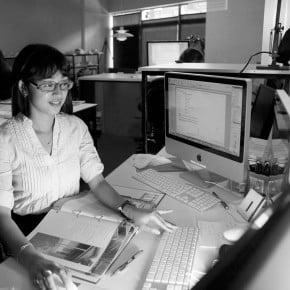How do you build a equitable and inclusive workplace? Antony Di Mase reflects on the training and team-building processes explored as he has developed his architectural practice.

“If you want to go quickly, go alone. If you want to go far, go together.”
– African proverb, quoted in “Our Choice” by Al Gore.
I started my own practice because I didn’t much like the politics of large firms and I found small practice dominated by the idiosyncrasies of its directors. Practice has, for me, become a design project unto itself – shaping its form and structure around the principles I bring to my architecture. That is, to make a difference to people’s lives through design and to share the experience with others.
Once my practice needed more people, I mostly employed students and recent graduates. Their lack of experience in the office was a real issue and so training and team building had to become a key part of the practice. Staff training started – way back when – as a set of simple constructions and contractual questions each week that tested their knowledge and research skills. It was pretty boring really, so the training evolved and we would visit and learn from others in the industry. For example we visited a joinery workshop, a tile shop and door hardware people and we had a presentation by a builder on good documentation. These people and others were incredibly generous with their time and were eager to share their craft and knowledge with us. I dedicate about two to three hours a week (about 5% of my staff’s work time) to training and to encouraging the team to learn and become more confident about asking questions and seeking answers.
The idea took hold within the office, and staff training has evolved to become part of a bigger discussion about the values and ideas that underpin our practice. I need to learn as well – so pretty much anything that interests me includes the rest of the team. Our Friday activities have now included workshop discussions on practice management, social media, communication and sustainability. We bring in or visit experts who have led discussions about their area of expertise, investigate what we do and how we communicate the work beyond our four walls. We have also visited galleries and undertaken activities such as clay model making. We have even done some work with local performers. Some ideas have worked better than others, but what has developed is a practice culture that is shared and valued.
I have learned that the relationships built around work are meaningful and that they are, of course, different to other relationships in our lives. There are boundaries and such relationships need to be principally built around the work of the practice. None of my staff are my Facebook friends and while we socialise it is not the main way we connect and communicate. The practice is about the work we do. It is important that the values and ideas are clear to all and that each person, including me, plays their role in implementing these ideas. The staff ‘buy-in to the game plan’ – to use footy speak – is crucial to our collective success as a practice. It is my role to bring overarching ideas and values to the practice and to ensure these ideas and values are implemented to their richest level for each and every project.
It is important to define open-ended roles for staff, so that they can grow into those roles. I seek to remove obstructions through the training and direction – so that they can fulfill their potential more quickly. For me, it is very much about getting young people to become project architects and to be able to manage a project with less and less intervention by me. Being their mentor is not the key here – in fact it is quite the opposite – it is to get them to become colleagues for whom sharing a vision for the practice is what matters. Measuring performance is easy because it is all about how well the ideas have been implemented and how much individuals are able to contribute to the well-being of the practice.
- Niea Nadya. Photo: Neo Feliciano.
- Melanie O’Brien. Photo: Neo Feliciano.
- Jim Stewart. Photo: David Fowler.
While much of these ideas probably come out of a social consciousness, it is really a business decision to do this training and mentoring work. To run a small practice that wants to grow and do better and better work is difficult. We all know that, and good people are needed to realise the potential of any practice. The business aim is all about retaining good staff for longer and attracting good staff as we continue to grow. When I started my practice I gave no thought to the impact of employing people and the effect this can have on their self-esteem and to their lives. It has been a pleasant surprise to see staff take on greater leadership roles at site meetings, client meetings, at our regular team meetings and to take strong positions on design issues. To see staff doing good work with little or no direction from me and for that work to be recognisably based on the ideas and values that have made this practice thrive has made the work worthwhile and enjoyable.
This work is not without its frustrations, mistakes and misgivings – but as with any long-term project it requires patience and faith. Training and mentoring has made a difference to my practice and it has been an experience that has been shared with others – something I set out to do when I started the practice. I enjoy seeing the transformation I can bring to clients through the work of the practice. In a similar way I have enjoyed employing good people and seeing them grow into fine young architects.























